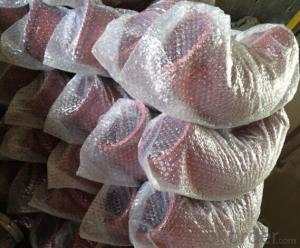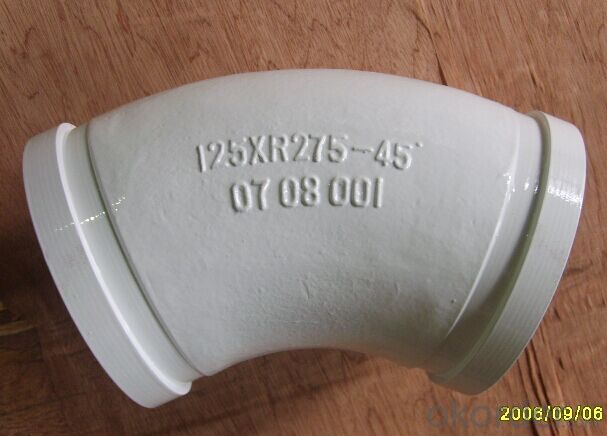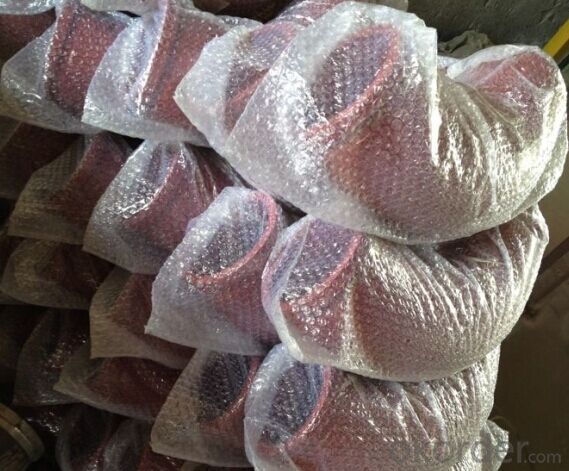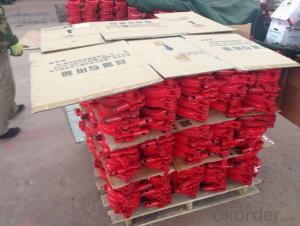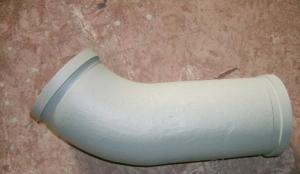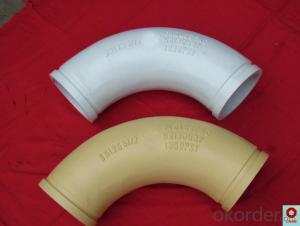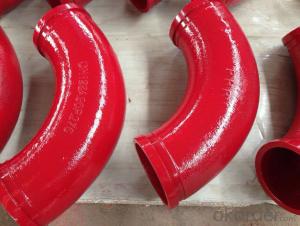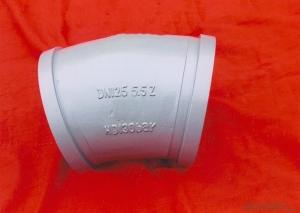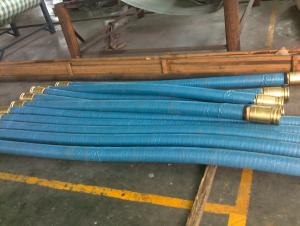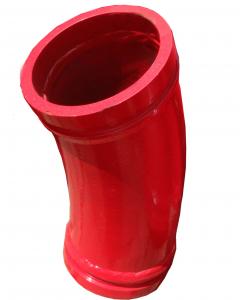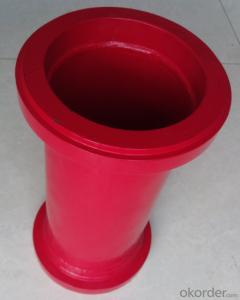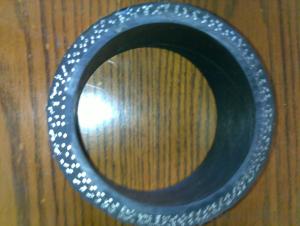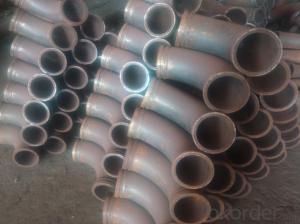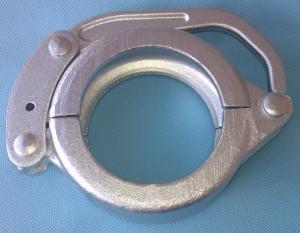CONCRETE DELIVERY ELBOW PM TYPE 45DEG R275 DN125
- Loading Port:
- Tianjin
- Payment Terms:
- TT OR LC
- Min Order Qty:
- 100 pc
- Supply Capability:
- 10000 pc/month
OKorder Service Pledge
OKorder Financial Service
You Might Also Like
concrete pump elbow table
Wear-resistant Single or Double Concrete Pump Elbow | |||||||
Type | Singe Elbow | Double Elbow | |||||
Model | DN125 | DN150 | DN175 | DN125 | |||
Material | Casting Steel ,ST52 | Inside | 40Cr | Outside | |||
Size | R275*90° | R275*90°+110 | 36° | F2000 | R275*90° | R275*90°+110 | |
R275*45° | R275*90°+211 | R400*30° | A3000 | R275*45° | R275*90°+211 | ||
R275*25° | R275*90°+411 | R400*45° | 471B | R275*25° | R275*90°+411 | ||
R275*20° | R275*90°+424 | R400*30° | 571B | R275*20° | R275*90°+424 | ||
R275*15° | R275*45°+170 | R488*90° | A1000 | R275*15° | R275*45°+170 | ||
R180*90° | R275*45°+310 | R500*90 | C1000 | R180*90° | R275*45°+310 | ||
R232*60° | R275*45°+310 | R280*90° | B2000 | R232*60° | R275*45°+310 | ||
R240*36° | 20°Lengthen | R240*36° | 20°Lengthen | ||||
R240*30° | 25°+740 | R240*30° | 25°+740 | ||||
R240*15° | 40°Zoomlion | R240*15° | 40°Zoomlion | ||||
R385*29° | R385*29° | ||||||
R315*33° | R315*33° | ||||||
Technic | Forged | ||||||
Average life | 25,000cubic | 50,000cubic | |||||
Appliciation | Used in concrete transport in construction work | ||||||
1.product profile:The double layer concrete pump elbow is developed by ourselves through new
technology and process.
2.characteristic:the inner layer of this concrete pump elbow undergoes heat treatment,and then the rigitiry can reach 62-65HRC.
3.characteristic:the outer layer of the concrete pump elbow possess good toughness properties
to protect the inner layer,so the security of the elbow is improved.
4.life:the experiment done abroad shows that the life of our concrete pump elbow can reach 35000-50000cbm,got the customers' praise
5.Beside the double layer concrete pump elbow,we produce all kinds of concrete pump parts,
straight pipe hose flange coupling and so on.
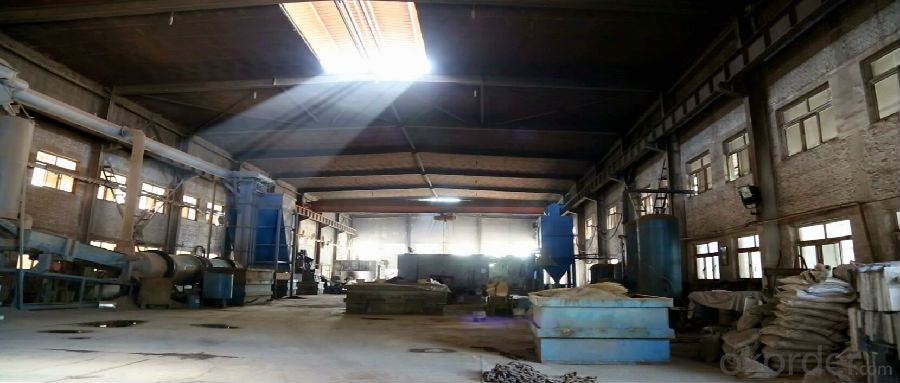
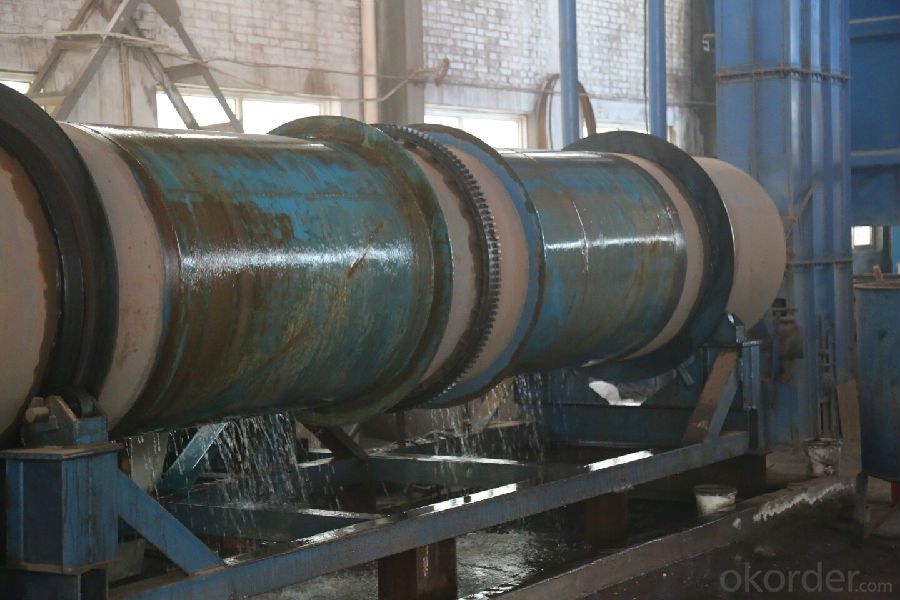
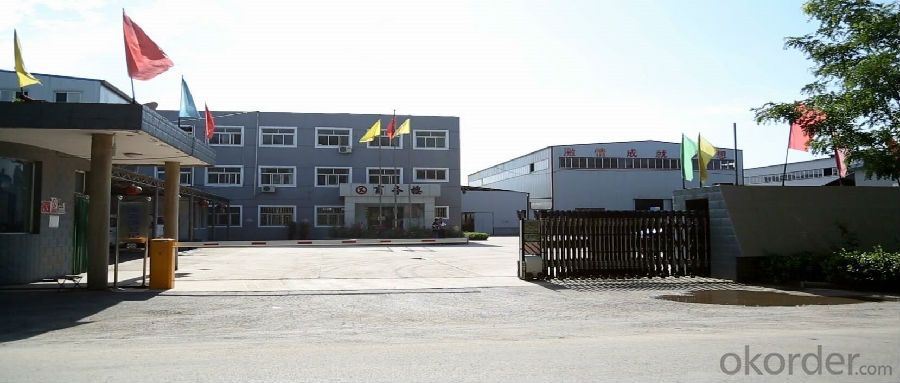
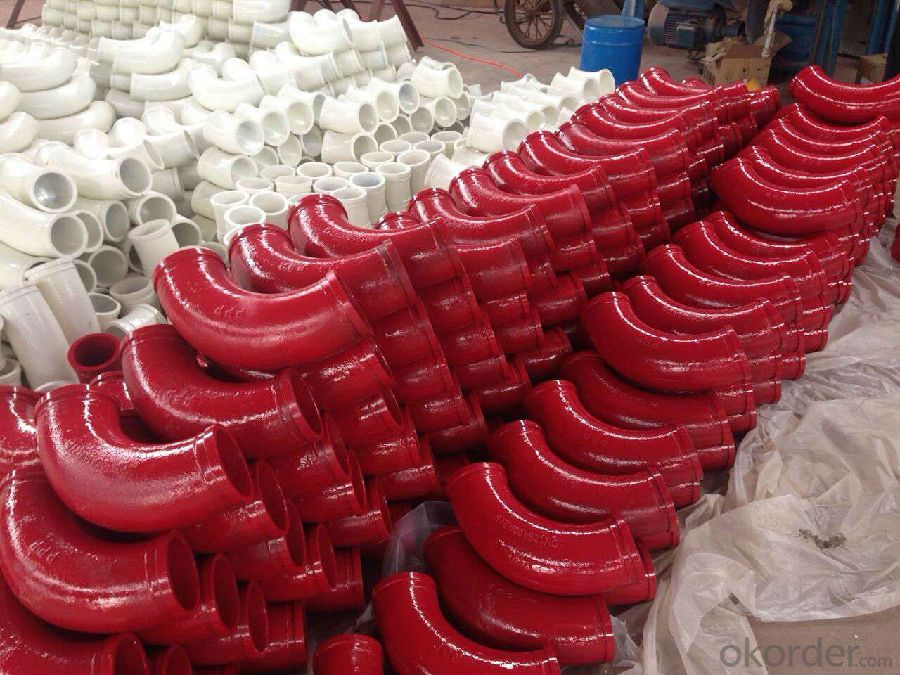
- Q: Are there any specific guidelines for the installation of pistons or cylinders in concrete pump spare parts?
- Installing pistons or cylinders in concrete pump spare parts requires adherence to specific guidelines. These guidelines play a vital role in guaranteeing the equipment's functionality and durability. 1. Thoroughly clean and inspect: Before installation, it is imperative to meticulously clean and inspect the pistons or cylinders to detect any damage or defects. Eliminating any debris or contaminants is essential to avoid potential operational issues. 2. Apply suitable lubrication: To minimize friction and ensure smooth movement, it is necessary to apply an appropriate lubricant to the piston or cylinder. This step also aids in preventing premature wear and tear, thereby extending the parts' lifespan. 3. Ensure proper alignment: Achieving proper alignment between the piston and cylinder is crucial. The piston must be correctly aligned with the cylinder bore to prevent binding or excessive wear. This can be accomplished by following the manufacturer's instructions or seeking professional guidance, if needed. 4. Adhere to torque specifications: Bolts or fasteners must be tightened according to the manufacturer's recommended torque specifications. Over-tightening or under-tightening can result in leaks or mechanical failure. 5. Use adequate sealing materials: To maintain an effective seal between the piston and cylinder, appropriate sealing materials such as gaskets or O-rings must be utilized. This prevents fluid leakage and preserves the equipment's efficiency. 6. Perform thorough testing: After installation, it is advisable to conduct tests to ensure the pistons or cylinders are functioning correctly. This may involve trial runs or pressure testing to identify any leaks or abnormalities. By adhering to these guidelines, the installation of pistons or cylinders in concrete pump spare parts can be executed accurately, resulting in reliable and efficient equipment operation. Referring to the manufacturer's instructions or seeking professional assistance is recommended if any doubts or concerns arise during the installation process.
- Q: What is the function of a concrete pump hydraulic filter?
- The function of a concrete pump hydraulic filter is to remove contaminants and impurities from the hydraulic fluid that is responsible for operating the pump. The hydraulic filter is designed to capture particles such as dirt, debris, and metal fragments that may be present in the hydraulic system. By removing these contaminants, the filter ensures that the hydraulic fluid remains clean and free from any potential damage-causing particles. This helps to maintain the overall performance and longevity of the concrete pump by preventing clogs, wear and tear, and potential damage to the pump's hydraulic components. Additionally, a clean hydraulic system reduces the risk of hydraulic fluid leakage, which can lead to costly repairs and downtime. Therefore, the concrete pump hydraulic filter plays a critical role in ensuring the efficiency, reliability, and durability of the pump's hydraulic system.
- Q: What are the different types of concrete pump hopper vibrators?
- There are two main types of concrete pump hopper vibrators: electric and pneumatic. Electric vibrators are powered by electricity and use an electric motor to generate vibrations. They are typically more powerful and efficient but require a power source. Pneumatic vibrators, on the other hand, are powered by compressed air and use air pressure to create vibrations. They are portable and do not require a power source, making them more suitable for remote or inaccessible areas.
- Q: Are there any specific guidelines for the installation of wear plates or cutting rings in concrete pump spare parts?
- Yes, there are specific guidelines for the installation of wear plates and cutting rings in concrete pump spare parts. These guidelines typically include instructions on proper alignment, torque specifications for bolts, and the use of appropriate lubricants. Following these guidelines ensures optimal performance and longevity of the wear plates and cutting rings in concrete pump spare parts.
- Q: How can one extend the lifespan of concrete pump spare parts?
- One can extend the lifespan of concrete pump spare parts by ensuring regular maintenance, proper lubrication, and cleaning after each use. Additionally, using high-quality spare parts and avoiding overloading or excessive pressure on the pump can also help prolong their lifespan.
- Q: Can I get spare parts for concrete pump hopper agitators and vibrators?
- Yes, you can get spare parts for concrete pump hopper agitators and vibrators.
- Q: How often should hopper grate springs be inspected or replaced in a concrete pump?
- Hopper grate springs in a concrete pump should be inspected regularly to ensure optimal performance and prevent any potential issues. The frequency of inspection or replacement depends on several factors such as the pump's usage, operating conditions, and the manufacturer's recommendations. However, a general guideline is to inspect the hopper grate springs at least once every six months or after every 500 hours of operation, whichever comes first. During the inspection, it is important to thoroughly examine the springs for any signs of wear, damage, or deformation. Look for cracks, excessive rust, or loss of tension in the springs. If any of these issues are detected, immediate replacement is necessary to maintain the proper functioning of the hopper grate system. Regular inspection and timely replacement of hopper grate springs are crucial to prevent clogging or blockage in the hopper, which could lead to pump malfunctions or downtime. It is advisable to consult the concrete pump manufacturer's guidelines or seek assistance from a professional technician to determine the specific inspection and replacement intervals based on the pump's make and model.
- Q: What is the purpose of a concrete pump boom?
- A concrete pump boom serves the purpose of efficiently and effectively transferring concrete from the mixer truck to the desired location on a construction site. Typically mounted on a truck or trailer, the boom consists of interconnected sections that can be extended and maneuvered to access otherwise difficult areas. Concrete pump booms offer numerous advantages compared to traditional concrete placement methods. Firstly, they greatly reduce the amount of labor needed for concrete placement. The boom can reach over obstacles like buildings or structures, eliminating the need for manual pouring or crane usage. This saves both time and money during construction projects. Moreover, concrete pump booms enable precise and accurate concrete placement. The boom can be controlled remotely, allowing the operator to position the nozzle exactly where the concrete is required. This ensures a more uniform and evenly distributed concrete placement, resulting in a higher quality finished product. Furthermore, concrete pump booms enhance safety on construction sites. By eliminating the need for workers to physically transport and pour concrete, the risk of injuries and accidents is significantly reduced. The boom also enables concrete placement in hard-to-reach areas, minimizing the need for workers to climb or work at heights, further enhancing safety. In conclusion, a concrete pump boom serves to provide a more efficient, precise, and safe method for transferring and placing concrete on construction sites. Its ability to overcome obstacles, accurately control placement, and reduce labor requirements make it an invaluable tool in the construction industry.
- Q: What is the purpose of a concrete pump hydraulic oil cooler?
- The primary function of a concrete pump hydraulic oil cooler is to keep the hydraulic oil in the system at the ideal temperature. The hydraulic oil powers the hydraulic system of the pump, which is responsible for operating different components like pistons, cylinders, and valves. While the pumping process is ongoing, the constant movement and pressure can cause the hydraulic oil to heat up. If the oil gets too hot, its viscosity decreases, which negatively impacts the overall efficiency and performance of the pump. Additionally, excessive heat can cause the hydraulic oil to deteriorate and break down, resulting in increased wear and tear on the pump's components. To prevent these problems, a concrete pump hydraulic oil cooler is utilized. It typically functions as a heat exchanger, transferring heat from the hydraulic oil to a cooling medium like air or water. This helps regulate the temperature of the hydraulic oil and keeps it within a safe operating range. By maintaining the optimal temperature, the hydraulic oil cooler guarantees that the hydraulic system functions efficiently and effectively. It also helps extend the pump's lifespan by reducing the risk of overheating and excessive component wear. Moreover, it preserves the quality of the hydraulic oil, allowing it to retain its lubricating properties and prevent any potential harm to the system. In conclusion, the goal of a concrete pump hydraulic oil cooler is to control the temperature of the hydraulic oil to optimize the performance, efficiency, and longevity of the pump's hydraulic system.
- Q: Can I get spare parts for concrete pump accessories like remote control systems?
- Yes, spare parts for concrete pump accessories like remote control systems are available. You can find them from various suppliers and manufacturers that specialize in concrete pump accessories.
Send your message to us
CONCRETE DELIVERY ELBOW PM TYPE 45DEG R275 DN125
- Loading Port:
- Tianjin
- Payment Terms:
- TT OR LC
- Min Order Qty:
- 100 pc
- Supply Capability:
- 10000 pc/month
OKorder Service Pledge
OKorder Financial Service
Similar products
Hot products
Hot Searches
Related keywords

